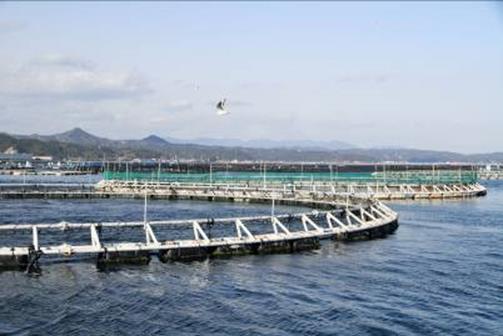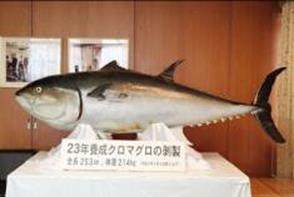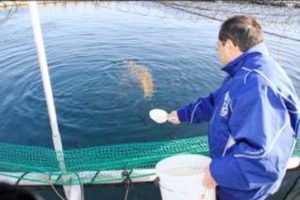Complete Farm-Raising Cycle for Bluefin Tuna at Kinki University
“One medium fatty tuna, please!” Until when will we be able to eat delicious tuna whenever we like?
Controls on the fishing of bluefin tuna have been tightened around the world in recent years. For example, at the 15th meeting of the Conference of the Parties to the Washington Convention (the Convention on International Trade in Endangered Species of Wild Fauna and Flora), held in Doha, Qatar, in March 2010, exactly one year ago, a total ban on international trade in Atlantic and Mediterranean bluefin tuna was discussed.
In recent years, because of their delicious taste, bluefin tuna have come to be eaten a lot in Europe, the United States, and Asia; they are especially popular among the wealthy in China. But the Japanese remain the principal consumers, accounting for about 80% of the total.
In this article, IHCSA Café introduces the research results and future activities of the Fisheries Laboratory of Kinki University, which has been continuing research on aquaculture methods for a shift “from fishing to farming” based on the theme of achieving a balance between the increased production of marine resources and the natural environment.

Japanese began to eat the fatty meat of tuna only recently
In terms of the history of tuna eating in Japan, the excavation of tuna bones from shell mounds dating from the Jomon period (ca 8000–300 BC) suggests that tuna were consumed a very long time ago.
In the Edo period (1603–1868) tuna fishing off the coasts of Boso and Miura Peninsulas was lively. The fish would rot before arrival in Edo (present-day Tokyo), so people would preserve it by cutting mainly the red meat into thin slices and soaking
them in soy sauce before eating. At that time the Japanese preferred simple tastes, like bonito and sardines, and apparently they did not like the fatty part of tuna very much.
It was in the 1950s and 1960s, during the period of high economic growth in Japan, that refrigeration technology advanced. Moreover, under the influence of rich Western-style cooking using butter and so on and other factors, tastes changed, and the Japanese began to relish the oily part of tuna meat.
Tighter controls on bluefin tuna fishing
 Did you know that there are two types of tuna aquaculture—farming using wild stock and complete-cycle farming? Wild stock farming involves catching wild young tuna in the sea and feeding them in cages until they grow into adults. In complete-cycle farming, adults raised from artificial hatching produce eggs, and the artificially hatched larvae grow into fry, younglings, and adults, which again produce eggs to repeat the cycle (hence the term “complete-cycle farming”).
Did you know that there are two types of tuna aquaculture—farming using wild stock and complete-cycle farming? Wild stock farming involves catching wild young tuna in the sea and feeding them in cages until they grow into adults. In complete-cycle farming, adults raised from artificial hatching produce eggs, and the artificially hatched larvae grow into fry, younglings, and adults, which again produce eggs to repeat the cycle (hence the term “complete-cycle farming”).
The difference between wild stock farming and complete-cycle farming is not very well understood generally, because the Japan Agricultural Standards allow the former to be labeled as “farmed” (in other words, completely farm-raised).
The problem with wild stock farming is that although not many adult fish are caught, a lot of young fish are harvested instead, so the result is that the total number of tuna is declining.
In addition, at the 7th Regular Session of the Western and Central Pacific Fisheries Commission (WCPFC) held in Honolulu in December 2010, it was decided that targeted bluefin tuna catches must not be greater than the 2002–4 level and that the catch of young fish must be lower than the 2002–4 level. Controls on bluefin tuna fishing have been tightening worldwide in recent years.
Building cages in the sea
In response to this situation, the activities of the Fishing Laboratory of Kinki University, which has succeeded in developing the world’s only complete farm-raising cycle for bluefin tuna, are attracting attention.
 After World War II, in an age when there was only deep-sea fishing, Koichi Seko, the first president of Kinki University, had the idea of floating cages in the sea. This was the beginning of aquaculture. Success was achieved in the cultivation of young yellowtail and such high-class fish as red sea bream and greater amberjack.
After World War II, in an age when there was only deep-sea fishing, Koichi Seko, the first president of Kinki University, had the idea of floating cages in the sea. This was the beginning of aquaculture. Success was achieved in the cultivation of young yellowtail and such high-class fish as red sea bream and greater amberjack.
The key to this successful cultivation was the method of small cage farming with fry developed by Teruo Harada, the second director of the Kinki University Fisheries Laboratory. This method, which involves raising fry in net cages placed in the sea, is now the mainstream in aquaculture around the world.
In 1970, under commission from the Fisheries Agency, the Kinki University Fisheries Laboratory began research on tuna farming. After three years the Fisheries Agency pulled out of the project, judging that tuna farming would be too difficult, but Kinki University carried on the research at its own expense, selling farm-raised young yellowtail, greater amberjack, and other fish in the market and using the proceeds to cover part of the research expenses.
These modest efforts bore fruit. In 2002 the Kinki University Fisheries Laboratory succeeded in the complete farm cultivation of bluefin tuna for the first time in the world, and in 2004 it accomplished the world’s first shipment of completely farm-raised bluefin tuna to the market.
What was it that led to this success? “Teamwork,” answered Dr. Osamu Murata, the fourth director of the Fisheries Laboratory Headquarters (Shirahama Experiment Station). “Everyone involved in this research had the same idea and came together with a determination to produce results. And every day we are modestly engaged in farming and observation. We are fish farmers—just like
shepherds!” The twinkle in Dr. Murata’s eyes reflected the confidence of a researcher doggedly absorbed in his studies.
Developing feed that does not use marine resources
 The Oshima Experiment Station, where the complete farm raising of bluefin tuna is being conducted, was opened in 1970 in the picturesque town of Kushimoto Oshima, which is situated on the southernmost tip of Honshu, about a 90-minute drive from the Fishing Laboratory’s headquarters. Here bluefin tuna are raised in 10 cages, each with a diameter of 30 m and divided by age.
The Oshima Experiment Station, where the complete farm raising of bluefin tuna is being conducted, was opened in 1970 in the picturesque town of Kushimoto Oshima, which is situated on the southernmost tip of Honshu, about a 90-minute drive from the Fishing Laboratory’s headquarters. Here bluefin tuna are raised in 10 cages, each with a diameter of 30 m and divided by age.
Dr. Yoshifumi Sawada, the head of the Oshima Experiment Station, showed us the cages of bluefin tuna. In the first cage that we were shown, about 600 young fish aged around six months after artificial hatching, measuring about 30 cm in length and weighing about 2 kg, were eagerly devouring the compound fertilizer feed developed by the station. In another cage, 30 adult fish aged nine years, measuring about 2 m in length and weighing around 170–290 kg, were swimming around elegantly. It was very impressive.
The bluefin tuna raised completely in these cages are sold on the market under the registered trademark of “Kindai (Kinki University) tuna.”
When they become adult, bluefin tuna are given such feed as mackerel and sardines. In order to increase their weight by 1 kg, they require about 15 kg of fish feed. Such feed is also a precious marine resource, and harvesting too much would destroy the marine ecosystem balance. Therefore, research is being conducted on the development of feed using vegetable protein, such as corn, instead of fish.
A lot of hope is being placed in the development of new bluefin tuna farm-raising techniques by the Kinki University Fishing Laboratory.
Kinki University
Fisheries Laboratory Headquarters (Shirahama Experiment Station)
3153 Shirahama, Nishimuro-gun, Wakayama Prefecture 649-2211
Tel.: 0739-42-2625
E-mail: suikensh@kindaisuiken.jp
Oshima Experiment Station
1790-4 Kushimoto Oshima, Higashimuro-gun, Wakayama Prefecture 649-3633
Tel.: 0735-65-0501
E-mail: suikenoh@za.ztv.ne.jp
http://www.flku.jp/english/index.html (English)
Photos: Fumio Kimiwada
